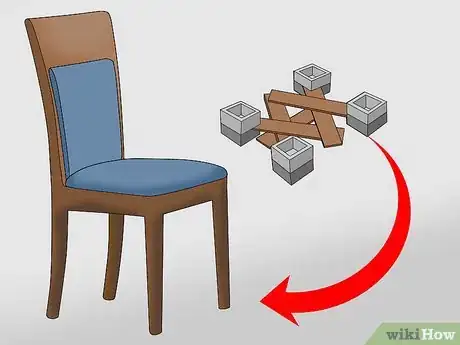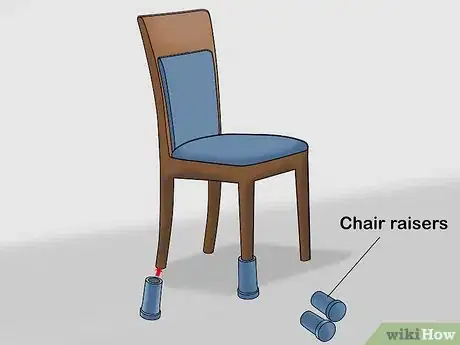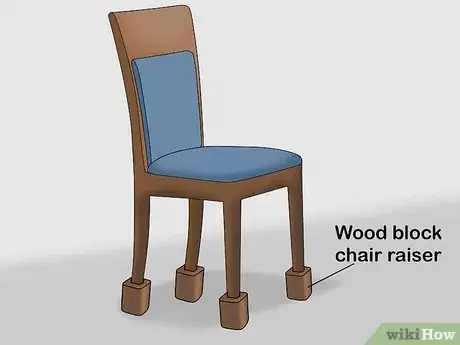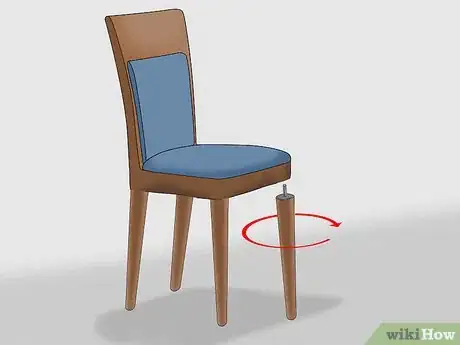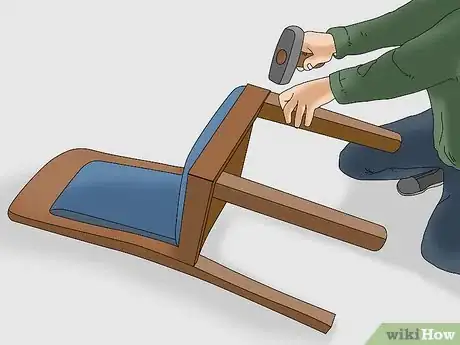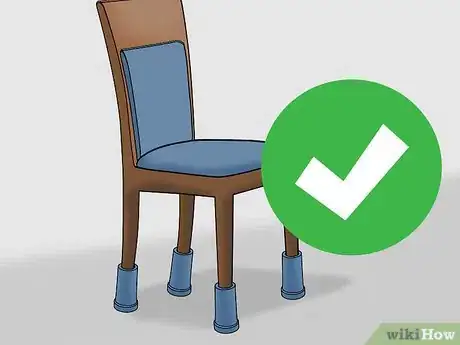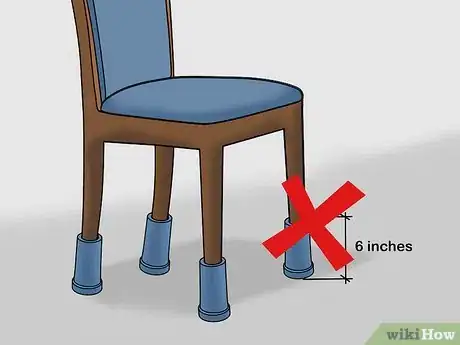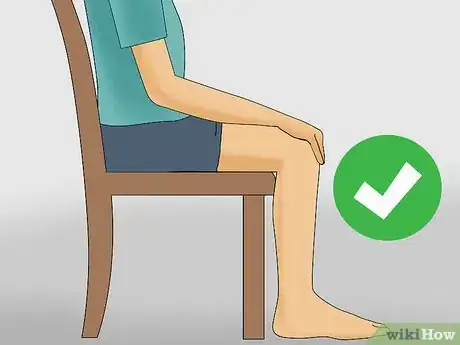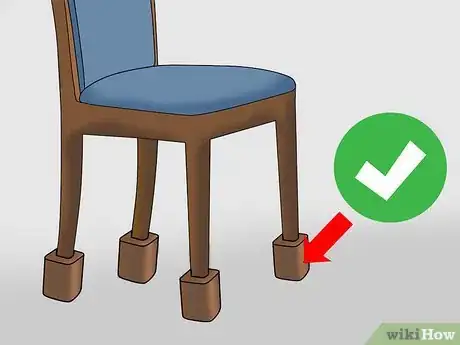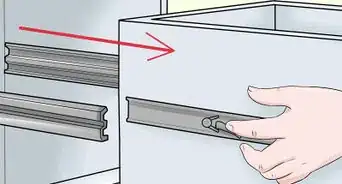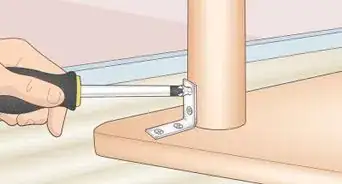This article was co-authored by wikiHow Staff. Our trained team of editors and researchers validate articles for accuracy and comprehensiveness. wikiHow's Content Management Team carefully monitors the work from our editorial staff to ensure that each article is backed by trusted research and meets our high quality standards.
This article has been viewed 109,836 times.
Learn more...
No furniture problem is quite as frustrating as a table that's too high for its dining chairs. If you want to raise your chair's height, however, you can do so in many different ways. Depending on your preference, you may try chair raisers, wooden blocks, chair cushions, or a variety of products to increase a dining chair's height. Before you know it, you'll be able to sit at your dining table comfortably!
Steps
Using Chair Raisers
-
1Choose interconnected chair raisers if you want stability. Although you can purchase individual chair raisers, interconnected designs tend to rock less. Interconnected chair raisers fit to the chair via highly adjustable raiser legs, which move in and out as well as to the side.[1]
- If you chose an interconnected chair raiser, you will only need 1 instead of 4.
- Interconnected chair raisers generally cost more than other raisers.
-
2Pick a height for your chair raisers. Chair raisers usually come in sizes from about 1 inch (2.5 cm) to 5 inches (13 cm). Decide how much higher you want your chairs to be and pick a chair raiser that comes in your desired height.[2]
- If you want you dining chairs to better fit a table's height, subtract the idea height of your chair from its current height to determine the right size for your raisers.
- Raisers are often one size fits most, but you may want to check the base's dimensions to make sure they're not too small for your chair legs.
Advertisement -
3Fit the chair's legs into the raisers. Chair raisers, both single and interconnected, have indentations for the chair leg to fit inside. Lift the chair and place the leg into the indentation, repeating this process for each of the chair's legs.[3]
- To ensure safety, all 4 of your chair's legs should have a raiser, unless you're using an interconnected raiser.
- Ask another person for help lifting the chair if fitting the raisers is beyond your physical capacity.
-
4Paint the raiser to match your chair's color. To give your chair raiser a stylish, low-profile finish, paint it the color of your chair. Apply 2-3 coats of paint, then seal it with a finish to prevent the color from chipping over time.
- Although you may not be able to find an exact color match, painting can help your chair raisers stand out less.
- Chair raisers often come in a variety of colors and finishes. Look for raisers that are the same color and made from the same material as your chair online or at a home improvement store.
Trying Alternative Methods
-
1Use wood blocks to match wooden chair legs. Wood blocks specifically designed for raising furniture can be an inexpensive way to increase a dining chair's height. Place a wood block under all of the chair's legs, and paint or stain your wood blocks to help them match the chair's color.
- Unlike chair raisers, wood blocks generally do not have holes for the . They are safe but less secure than raisers for this reason.
- You can get chair raisers online or at many home improvement stores in a variety of heights and finishes. Choose a block height that matches how much taller you want the chair to be.
-
2Try casters if you want a rolling option for hard floors. Casters are detachable wheels that lift your dining chair's height and make it more portable. Attaching the casters is different for each brand but usually involves drilling holes in the chair's leg bottoms and screwing the caster in place.
- Casters are more noticeable than other chair lifting options.
-
3Use chair cushions to add a small amount of height. A chair cushion can lift your seated height while keeping you comfortable. If you only need to raise the height 5 inches (13 cm) or lower, buy a dining chair cushion and tie it to your seat.[4]
- Of all options, chair cushions generally add the least amount of height.
-
4Replace screw-in chair legs with taller ones. Because most chair legs screw into the body of the chair, you can also buy replacement screw-in legs that are taller than the original legs. Unscrewing old legs and screwing in new legs may be the easiest option for beginners. You can buy replacement screw-in legs at hardware stores or order them online.
- Be sure you buy 4 identical replacement legs for each chair.
- If you are an experienced woodworker, you can also replace the legs yourself. Replacing chair legs is not for amateur woodworkers, however, to ensure that the new chair legs are even and safe.
-
5Hire a carpenter to replace your chair legs. If you want to raise your chair's legs without changing its overall look, ask a carpenter about refitting your chair with new legs. Your carpenter can make legs for your chair that look like the old ones but are long enough to raise its height.[5]
- Keep in mind that replacing chair legs is permanent and may devalue expensive or vintage chairs.
Raising Chairs Safely
-
1Check the chair's stability prior to use. After increasing the chair's height, sit on it carefully. Evaluate the chair's sturdiness—if it feels wobbly, adjust the chair's rising equipment until sitting on it feels secure.[6]
- Be careful when sitting on the chair for the first time in case it slips or falls over.
-
2Do not raise your chairs more than 6 inches (15 cm). Lifting your chairs any higher can make your chair unstable. If you need seats more than 6 inches (15 cm) above their current heights, you may need to buy new chairs.[7]
-
3Check the chair rising equipment's maximum weight limit. Read the label or contact the manufacturer to find out the chair accessories' maximum weight limit. Factor in the chair's weight and the average weight of those sitting on it to determine which chair rising equipment is safest.[8]
- To prevent injuries, do not exceed the equipment's maximum weight limit.
-
4Make sure you've adjusted the chair legs to a comfortable height. Individuals that use the chair should be able to sit and stand easily. As a guideline, their feet should lie flat on the ground or footrest while sitting down. Compare these measurements to how the person who sits in this chair most looks while sitting in it. Adjust higher or lower as needed.[9]
- If many people use this chair, choose the average height as a guideline.
- Chairs that are too high can cause poor blood circulation, put strain on your knees, and constrict the nerves in your legs.[10]
-
5Readjust the raising equipment as you move the chairs. If you move the chairs, check the equipment's fit on each of the chair's legs. Even small movements can change the equipment's alignment in dangerous ways.[11]
Warnings
- Only use products designed for raising chair heights. Using books, generic wood blocks, or other household objects can make your chairs wobbly and unsafe to sit on.⧼thumbs_response⧽
- Broken rising equipment is a safety hazard. Inspect anything you use to raise the chair for damage before using it.[13]⧼thumbs_response⧽
References
- ↑ http://www.livingmadeeasy.org.uk/scenario.php?csid=155
- ↑ http://www.livingmadeeasy.org.uk/scenario.php?csid=155
- ↑ http://www.cec.health.nsw.gov.au/__data/assets/pdf_file/0009/327717/Chair-and-Bed-Raisers-Equipment-installation-and-safe-use-July-2016.pdf
- ↑ http://www.livingmadeeasy.org.uk/scenario.php?csid=155
- ↑ https://www.popularmechanics.com/home/interior-projects/how-to/g2538/furniture-problems-you-can-fix/
- ↑ http://www.cec.health.nsw.gov.au/__data/assets/pdf_file/0009/327717/Chair-and-Bed-Raisers-Equipment-installation-and-safe-use-July-2016.pdf
- ↑ https://theotprocess.wordpress.com/2016/07/05/practical-guides-6-raising-chairs-settees-and-beds/
- ↑ http://www.livingmadeeasy.org.uk/scenario.php?csid=155
- ↑ https://ilcaustralia.org.au/Using_Assistive_Technology/in_the_home/seating
- ↑ http://ergo.human.cornell.edu/dea3250flipbook/dea3250notes/sitting.html
- ↑ http://www.cec.health.nsw.gov.au/__data/assets/pdf_file/0009/327717/Chair-and-Bed-Raisers-Equipment-installation-and-safe-use-July-2016.pdf
- ↑ https://ilcaustralia.org.au/Using_Assistive_Technology/in_the_home/seating
- ↑ http://www.cec.health.nsw.gov.au/__data/assets/pdf_file/0009/327717/Chair-and-Bed-Raisers-Equipment-installation-and-safe-use-July-2016.pdf
About This Article
If your dining chairs are too short, there are a few different ways you can make them taller. One easy option is to attach chair raisers to the chair legs. Chair raisers usually come in sizes between 1 and 5 inches, and you can paint them to match the color of your chairs if you'd like. Another option is to replace the legs on your chairs with taller ones if the legs are removable. If you have hard floors, you can also attach casters, which are small wheels that go on the bottom of the legs. To make your seats softer while raising their height, go for chair cushions instead. For more tips, including how to safely raise your chair legs so they don't wobble, read on!

